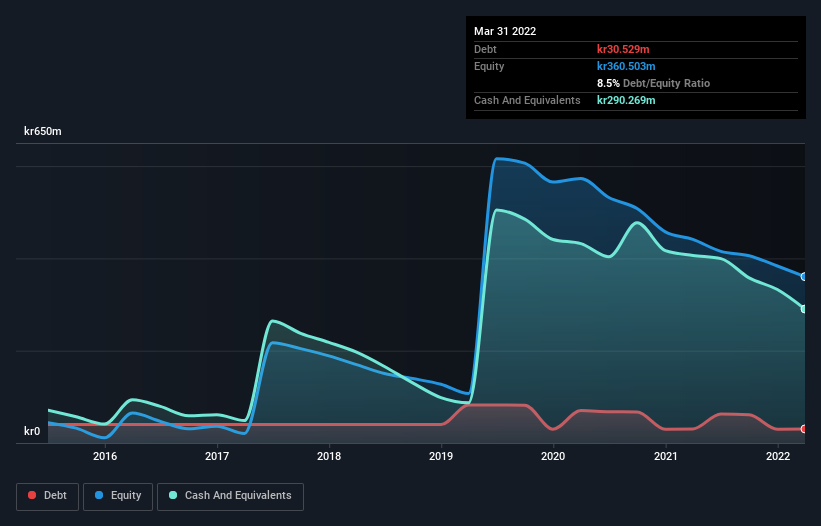Some say volatility, rather than debt, is the best way to think about risk as an investor, but Warren Buffett famously said that 'Volatility is far from synonymous with risk.' When we think about how risky a company is, we always like to look at its use of debt, since debt overload can lead to ruin. We note that PowerCell Sweden AB (publ) (STO:PCELL) does have debt on its balance sheet. But is this debt a concern to shareholders?
What Risk Does Debt Bring?
Debt is a tool to help businesses grow, but if a business is incapable of paying off its lenders, then it exists at their mercy. If things get really bad, the lenders can take control of the business. However, a more usual (but still expensive) situation is where a company must dilute shareholders at a cheap share price simply to get debt under control. By replacing dilution, though, debt can be an extremely good tool for businesses that need capital to invest in growth at high rates of return. When we examine debt levels, we first consider both cash and debt levels, together.
View our latest analysis for PowerCell Sweden
What Is PowerCell Sweden's Debt?
The chart below, which you can click on for greater detail, shows that PowerCell Sweden had kr30.5m in debt in March 2022; about the same as the year before. But on the other hand it also has kr290.3m in cash, leading to a kr259.7m net cash position.

How Healthy Is PowerCell Sweden's Balance Sheet?
We can see from the most recent balance sheet that PowerCell Sweden had liabilities of kr74.6m falling due within a year, and liabilities of kr59.4m due beyond that. Offsetting these obligations, it had cash of kr290.3m as well as receivables valued at kr72.5m due within 12 months. So it can boast kr228.8m more liquid assets than total liabilities.
This short term liquidity is a sign that PowerCell Sweden could probably pay off its debt with ease, as its balance sheet is far from stretched. Simply put, the fact that PowerCell Sweden has more cash than debt is arguably a good indication that it can manage its debt safely. There's no doubt that we learn most about debt from the balance sheet. But ultimately the future profitability of the business will decide if PowerCell Sweden can strengthen its balance sheet over time. So if you're focused on the future you can check out this free report showing analyst profit forecasts.
Over 12 months, PowerCell Sweden reported revenue of kr160m, which is a gain of 50%, although it did not report any earnings before interest and tax. Shareholders probably have their fingers crossed that it can grow its way to profits.
So How Risky Is PowerCell Sweden?
By their very nature companies that are losing money are more risky than those with a long history of profitability. And the fact is that over the last twelve months PowerCell Sweden lost money at the earnings before interest and tax (EBIT) line. Indeed, in that time it burnt through kr113m of cash and made a loss of kr83m. With only kr259.7m on the balance sheet, it would appear that its going to need to raise capital again soon. With very solid revenue growth in the last year, PowerCell Sweden may be on a path to profitability. By investing before those profits, shareholders take on more risk in the hope of bigger rewards. When analysing debt levels, the balance sheet is the obvious place to start. But ultimately, every company can contain risks that exist outside of the balance sheet. These risks can be hard to spot. Every company has them, and we've spotted 2 warning signs for PowerCell Sweden you should know about.
Of course, if you're the type of investor who prefers buying stocks without the burden of debt, then don't hesitate to discover our exclusive list of net cash growth stocks, today.
New: Manage All Your Stock Portfolios in One Place
We've created the ultimate portfolio companion for stock investors, and it's free.
• Connect an unlimited number of Portfolios and see your total in one currency
• Be alerted to new Warning Signs or Risks via email or mobile
• Track the Fair Value of your stocks
Have feedback on this article? Concerned about the content? Get in touch with us directly. Alternatively, email editorial-team (at) simplywallst.com.
This article by Simply Wall St is general in nature. We provide commentary based on historical data and analyst forecasts only using an unbiased methodology and our articles are not intended to be financial advice. It does not constitute a recommendation to buy or sell any stock, and does not take account of your objectives, or your financial situation. We aim to bring you long-term focused analysis driven by fundamental data. Note that our analysis may not factor in the latest price-sensitive company announcements or qualitative material. Simply Wall St has no position in any stocks mentioned.
About OM:PCELL
PowerCell Sweden
Develops and produces fuel cells and fuel cell systems for automotive, marine, and stationary applications in Sweden and internationally.
Reasonable growth potential with adequate balance sheet.
Similar Companies
Market Insights
Community Narratives



